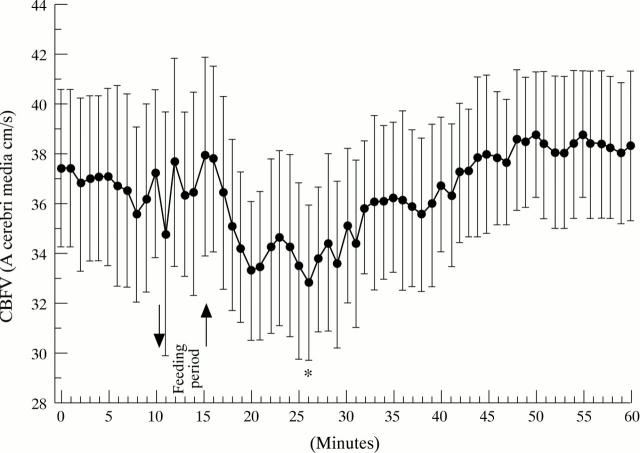Abstract
AIM—To study continuously cerebral blood flow velocity in the middle cerebral artery before, during, and after tube feeding in neonates. METHOD—Cerebral blood flow velocity was measured in 14 neonates using a Doppler ultrasound device. Blood pressure, respiration, and oxygen saturation were monitored. RESULTS—Mean blood flow velocity decreased from 37 cm/s before feeding to 33 cm/s (P<0.001) 5 to 11 minutes after feeding. Prefeeding values were reached after 17 minutes. Arterial blood pressure, respiration patterns, and oxygen saturation did not change significantly during the study period. CONCLUSION—Tube feeding in preterm infants may decrease cerebral perfusion, despite unchanged blood pressure and unchanged oxygen saturation. Keywords: tube feeding; cerebral blood flow velocity; blood pressure; oxygen saturation.
Full Text
The Full Text of this article is available as a PDF (95.8 KB).
Figure 1 .
Mean (SE) cerebral blood flow velocity in the middle cerebral artery before ("prefreeding" values), during (5-10 minutes), and after bolus tube feeding. P <0.001 when "prefeeding" values were compared with those 5 to 16 minutes after feeding.
Selected References
These references are in PubMed. This may not be the complete list of references from this article.
- Dear P. R. Effect of feeding on jugular venous blood flow in the normal newborn infant. Arch Dis Child. 1980 May;55(5):365–370. doi: 10.1136/adc.55.5.365. [DOI] [PMC free article] [PubMed] [Google Scholar]
- Fenton A. C., Evans D. H., Levene M. I. On line cerebral blood flow velocity and blood pressure measurement in neonates: a new method. Arch Dis Child. 1990 Jan;65(1 Spec No):11–14. doi: 10.1136/adc.65.1_spec_no.11. [DOI] [PMC free article] [PubMed] [Google Scholar]
- Ipsiroglu O. S., Steck J., Michel E., Pessenhofer H., Jorch G., Pollak A. Are adult transcranial Doppler systems suitable for application in neonates? Eur J Pediatr. 1996 Nov;155(11):942–947. doi: 10.1007/BF02282884. [DOI] [PubMed] [Google Scholar]
- Jahnukainen T., Lindqvist A., Vuorinen M., Jalonen J., Välimäki I. Post-prandial effects in reactivity of forehead and mid-femoral skin blood flow and heart rate in neonates. Early Hum Dev. 1994 Nov 18;39(3):189–200. doi: 10.1016/0378-3782(94)90197-x. [DOI] [PubMed] [Google Scholar]
- Krauss A. N., Brown J., Waldman S., Gottlieb G., Auld P. A. Pulmonary function following feeding in low-birth-weight infants. Am J Dis Child. 1978 Feb;132(2):139–142. doi: 10.1001/archpedi.1978.02120270037008. [DOI] [PubMed] [Google Scholar]
- Leidig E. Doppler analysis of superior mesenteric artery blood flow in preterm infants. Arch Dis Child. 1989 Apr;64(4 Spec No):476–480. doi: 10.1136/adc.64.4_spec_no.476. [DOI] [PMC free article] [PubMed] [Google Scholar]
- Martinussen M., Brubakk A. M., Vik T., Yao A. C. Mesenteric blood flow velocity and its relation to transitional circulatory adaptation in appropriate for gestational age preterm infants. Pediatr Res. 1996 Feb;39(2):275–280. doi: 10.1203/00006450-199602000-00015. [DOI] [PubMed] [Google Scholar]
- Nelle M., Höcker C., Zilow E. P., Linderkamp O. Effects of red cell transfusion on cardiac output and blood flow velocities in cerebral and gastrointestinal arteries in premature infants. Arch Dis Child Fetal Neonatal Ed. 1994 Jul;71(1):F45–F48. doi: 10.1136/fn.71.1.f45. [DOI] [PMC free article] [PubMed] [Google Scholar]
- Patel B. D., Dinwiddie R., Kumar S. P., Fox W. W. The effects of feeding on arterial blood gases and lung mechanics in newborn infants recovering from respiratory disease. J Pediatr. 1977 Mar;90(3):435–438. doi: 10.1016/s0022-3476(77)80711-7. [DOI] [PubMed] [Google Scholar]
- Prechtl H. F. The behavioural states of the newborn infant (a review). Brain Res. 1974 Aug 16;76(2):185–212. doi: 10.1016/0006-8993(74)90454-5. [DOI] [PubMed] [Google Scholar]
- Rahilly P. M. Effects of sleep state and feeding on cranial blood flow of the human neonate. Arch Dis Child. 1980 Apr;55(4):265–270. doi: 10.1136/adc.55.4.265. [DOI] [PMC free article] [PubMed] [Google Scholar]
- Raziuddin K., Kim M. H., Yao A. C. Peripheral circulatory response to feeding in newborn low-birth-weight infants. J Pediatr Gastroenterol Nutr. 1984;3(1):89–94. doi: 10.1097/00005176-198401000-00019. [DOI] [PubMed] [Google Scholar]
- Rennie J. M., South M., Morley C. J. Cerebral blood flow velocity variability in infants receiving assisted ventilation. Arch Dis Child. 1987 Dec;62(12):1247–1251. doi: 10.1136/adc.62.12.1247. [DOI] [PMC free article] [PubMed] [Google Scholar]
- Wilkinson A., Yu V. Y. Immediate effects of feeding on blood-gases and some cardiorespiratory functions in ill newborn infants. Lancet. 1974 Jun 1;1(7866):1083–1085. doi: 10.1016/s0140-6736(74)90558-3. [DOI] [PubMed] [Google Scholar]
- Yao A. C., Wallgren C. G., Sinha S. N., Lind J. Peripheral circulatory response to feeding in the newborn infant. Pediatrics. 1971 Feb;47(2):378–383. [PubMed] [Google Scholar]



